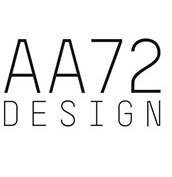My favourite soundbite was something to do with how a smartphone "contains around 17 of the rarest metals on the planet". I decided to mock up a poster to illustrate this fact, using gold foil on black, as gold is surely the first precious metal that people think of (I am not sure if it actually in smartphones - must check). I chose to use the recognisable silhouette of an iPhone 4 to represent smartphones. Here's a mockup of how it will look:
I figured this would look beautiful screenprinted using gold foil onto black card. Unfortunately there were lots of problems achieving the desired effect. First off I had to screenprint the foil glue onto the paper. I figured this would be the same as printing regular ink but alas no. Firstly, the foil glue is much thinner than the inks. Secondly, it dries into the screen in under a minute. I had to use the power-washer to get the glue out, which had the unfortunate side effect of stripping the stencil too! So, I made my screen up again and had to print the glue as a one-shot deal - no time to do a few tests on newsprint.
Once the glue is on the paper, you leave it to dry completely. You then apply the foil over the glue and put it into the heat press. Our print technician Ed had only done this once or twice during his second year, so it was going to be a bit hit and miss. Anyway, here is the result:
Once the glue is on the paper, you leave it to dry completely. You then apply the foil over the glue and put it into the heat press. Our print technician Ed had only done this once or twice during his second year, so it was going to be a bit hit and miss. Anyway, here is the result:
The cracked effect on the smartphone itself is quite nice but it is not what I was after - I wanted it to be totally smooth gold. I am quite pleased with the legibility of the text as it is quite small (12pt Myriad Pro) but unfortunately the "17" didn't print, so it doesn't make much sense. It is supposed to read:
Your smartphone contains around 17
of the rarest metals on the planet.
It is not currently possible to reclaim
these and reuse them.
I am not sure quite why all of the text didn't print. Perhaps it had something to do with the temperature or duration of the heat press. If the folk at Bath Uni like the idea then I will look into getting these printed professionally. At least I have done enough to prove the concept and figure out that doing it myself at uni is not an option.
My second attempt achieved about the same level of success. This time the factoid was about the precious metals that are deposited on the roads thanks to their use in catalytic converters. The actual quote I remember went something like:
The catalytic converters found in regular cars use a matrix coated in palladium, rhodium and platinum to filter out harmful pollutants. Over time, traces of these precious metals are released onto the tarmac.
It is estimated that there is currently more platinum on the roads of Birmingham than in the largest mine in the world.
Now, I know that this statement is not actually correct but it was something like that and I am only using it to illustrate an idea. I thought it would be apt create a map of all the roads in Birmingham using platinum foil, again onto black mount board. Here's the mock:
Your smartphone contains around 17
of the rarest metals on the planet.
It is not currently possible to reclaim
these and reuse them.
I am not sure quite why all of the text didn't print. Perhaps it had something to do with the temperature or duration of the heat press. If the folk at Bath Uni like the idea then I will look into getting these printed professionally. At least I have done enough to prove the concept and figure out that doing it myself at uni is not an option.
My second attempt achieved about the same level of success. This time the factoid was about the precious metals that are deposited on the roads thanks to their use in catalytic converters. The actual quote I remember went something like:
The catalytic converters found in regular cars use a matrix coated in palladium, rhodium and platinum to filter out harmful pollutants. Over time, traces of these precious metals are released onto the tarmac.
It is estimated that there is currently more platinum on the roads of Birmingham than in the largest mine in the world.
Now, I know that this statement is not actually correct but it was something like that and I am only using it to illustrate an idea. I thought it would be apt create a map of all the roads in Birmingham using platinum foil, again onto black mount board. Here's the mock:
The map printed really nicely, although the text was not quite so good. Again, if the Bath Uni guys like this idea then I will look into getting it done professionally.




















































